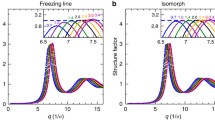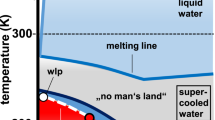Abstract
The theory of the liquid to solid transition, in three as well as in two dimensions, is reviewed. The transition can be viewed either as the melting of the solid due to phonon or defect proliferation instabilities or alternatively as freezing of the liquid into a density wave state with crystalline symmetry. A theory due to Yussouff and the author, based on the latter idea, is discussed and its predictions are compared with experiment. It is shown that the theory leads to a new approach to the properties of a deformed (e.g., sheared) solid and of defects such as grain boundaries and dislocations in a solid. The approach brings out explicitly the structural nature of these properties, and is not restricted to small deviations from perfect periodicity (harmonic approximation) since the solid, the liquid and anything in between can be handled theoretically.
Similar content being viewed by others
References
Berezinskii L 1970Sov. Phys. JETP 32 493
Broughton J, Gilmer G and Weeks J D 1982Phys. Rev. B25 4651
Chui S T 1982Phys. Rev. Lett. 48 933
Chui S T 1983Phys. Rev. B28 178
Clark N Aet al 1983Phys. Rev. Lett. 50 1459
Cotterill R M J 1980Ordering in strongly fluctuating condensed matter systems (ed.) T Riste (New York: Plenum) p 26
Grimvall G 1977Third International Conference on Liquid Metals (ed.) R Evans (Bristol: Inst. of Physics) p 90
Halperin B I and Nelson D R 1979aPhys. Rev. Lett. 41 (121)
Halperin B I and Nelson D R 1979bPhys. Rev. B19 2457
Haymet A D J and Oxtoby D W 1981J. Chem. Phys. 74 2559
Kosterlitz J M and Thouless D J 1973J. Phys. C 6 1181
Krishnamurthy H R and Ramakrishnan T V 1984 (to be published)
Lindemann F A 1910Z. Phys. 11 609
Longuet-Higgins H C and Widom B 1964Mol. Phys. 8 549
Mott N F and Gurney R W 1939Trans. Faraday Soc. 35 364
Oxtoby D W and Haymet A D J 1982J. Chem. Phys. 76 6262
Pines D 1964Elementary excitations in solids (New York: Benjamin)
Platzman P M and Fukuyama H 1974Solid State Commun. 15 677
Ramakrishnan T V and Yussouff M 1977Solid State Commun. 21 389
Ramakrishnan T V and Yussouff M 1979Phys. Rev. B19 2775
Ramakrishnan T V 1982Phys. Rev. Lett. 48 541
Saitoh Y 1982Phys. Rev. Lett. 48 1114
Shockley W 1952L’Etat Solide (Ninth Solvay Conference, Brussels Belgium) p 431
Stishov S M 1975Soviet Physics Usp. 17 625
Ubbehlode 1965Melting and crystal structure (Oxford: Clarendon Press)
Verlet L 1969Phys. Rev. 184 150
Young A P 1979Phys. Rev. B19 1855
Yussouff M 1981Phys. Rev. B23 5871
Author information
Authors and Affiliations
Rights and permissions
About this article
Cite this article
Ramakrishnan, T.V. Density wave theory of freezing and the solid. Pramana - J Phys 22, 365–375 (1984). https://doi.org/10.1007/BF02846386
Issue Date:
DOI: https://doi.org/10.1007/BF02846386




